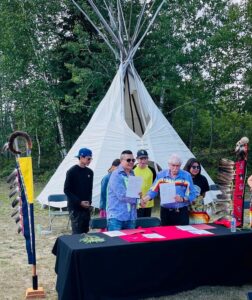Biigtigong Nishnaabeg and Netmizaaggamig Nishnaabeg sign Territory Overlap Agreement

By Rick Garrick
NETMIZAAGGAMIG NISHNAABEG — Biigtigong Nishnaabeg and Netmizaaggamig Nishnaabeg recently signed a Territory Overlap Agreement focused on partnership and continued relationship building on July 31 at Netmizaaggamig’s Powwow Gathering Grounds. The Territory Overlap Agreement, the first of its kind in the Northern Superior Region, was achieved after years of commitment and work by each community to continue to strengthen the relationship to each other and the land and waters for which they exist.
“We signed a treaty as well, it wasn’t just an overlap agreement, we signed a treaty between ourselves and exchanged a little bit of wampum string between us to solidify the agreement,” says Biigtigong Nishnaabeg Chief Duncan Michano, noting that he met with former Netmizaaggamig Nishnaabeg Chief Wayne Sabourin in about 2013-2014 to sort out where their traditional territories were and where they wanted to overlap. “We sat down and looked over maps and decided on where that line should go based on everybody’s traditional use, a little bit of give and take here and there. The Agreement is there to delineate political boundaries, where are our political boundaries, where are our economic boundaries, and we have put that in practice for probably the last three or four years even before the signing, so we were respecting each other’s boundaries in regards to jurisdiction.”
Netmizaaggamig Nishnaabeg Chief Louis Kwissiwa says the work on the Territory Overlap Agreement has united the two First Nations, which are located between Marathon and White River.
“We did mapping between the two communities and the overlap allowed us to work together and to find some commonalities in those overlapped areas where we shared territories,” Chief Kwissiwa says. “We found that sharing is more beneficial to each First Nation rather than drawing hard lines.”
Kwissiwa says the Territory Overlap Agreement ceremony and celebration began with a Pipe Ceremony.
“We acknowledged each other’s traditional territory and we signed [the Agreement] and there was a big celebration,” Chief Kwissiwa says. “We had a few words from the leadership from each community just explaining how we would work together going into the future, how we would call upon each other if we need each other and how we would allow each other to use the land if we needed from each other’s particular territory.”
Chief Kwissiwa says there has been a good response to the Territory Overlap Agreement.
“It’s all been good responses, this is the way things should be done,” Chief Kwissiwa says.
Chief Michano says he believes that every First Nation across the country should be negotiating territory overlap agreements with their neighbours.
“It gives certainty about where you have jurisdiction and where your political boundaries are,” Chief Michano says, noting that the Territory Overlap Agreement does not cover hunting and fishing. “We’ll still be able to hunt and fish on each other’s land just like we used to, but as we start to have more jurisdiction over wildlife management, there may be times when we want to close certain portions or certain lakes due to over-fishing and over-hunting and try to manage wildlife and the fisheries.”
Chief Kwissiwa says he recently travelled across White Lake from his community, which is located on the southern side of White Lake, and up the Shabotik River.
“I went up the Shabotik River and it’s a beautiful territory up there and it just took me back to a place when I thought about our ancestors and how they used to travel the waters and the river systems,” Chief Kwissiwa says. “As a part of this treaty agreement between the two First Nations, we’re encouraging our people and especially our youth to get back out there on the land to utilize our territory, whether you’re on the water or on the land. I know Chief Duncan (Michano) is an avid land user and for myself, I’m just getting back out there. As a result (of the Territory Overlap Agreement) I’m going back out and I plan on bringing my kids a lot more and to get them back on the land.”


